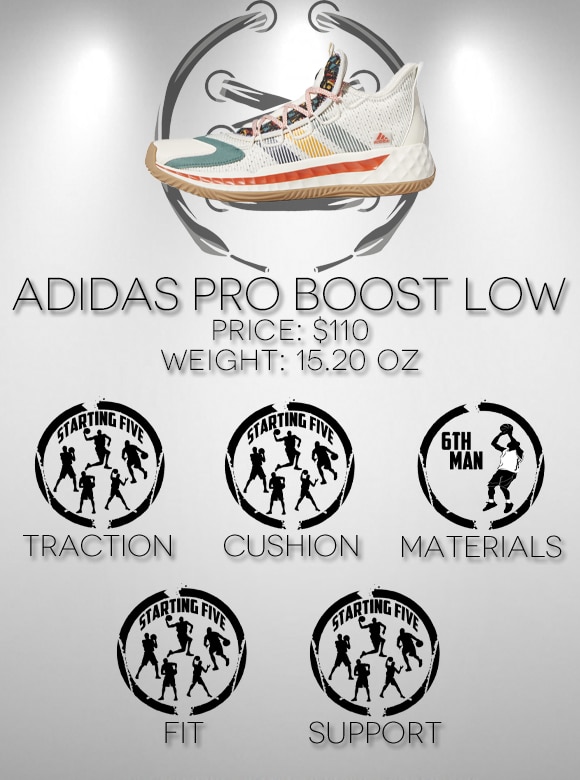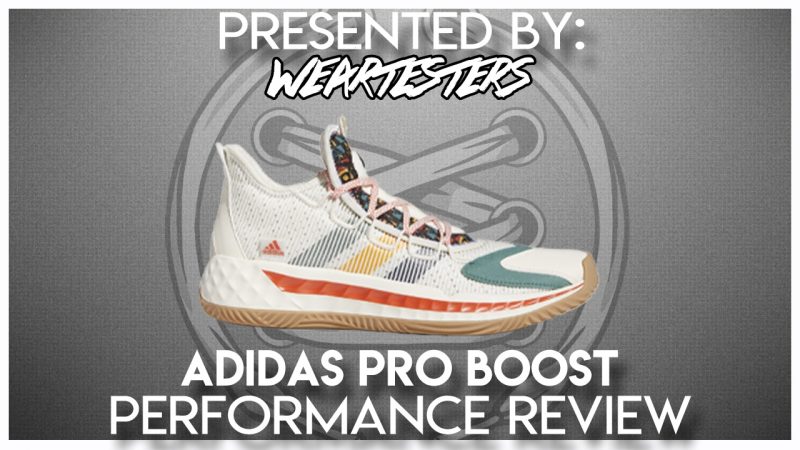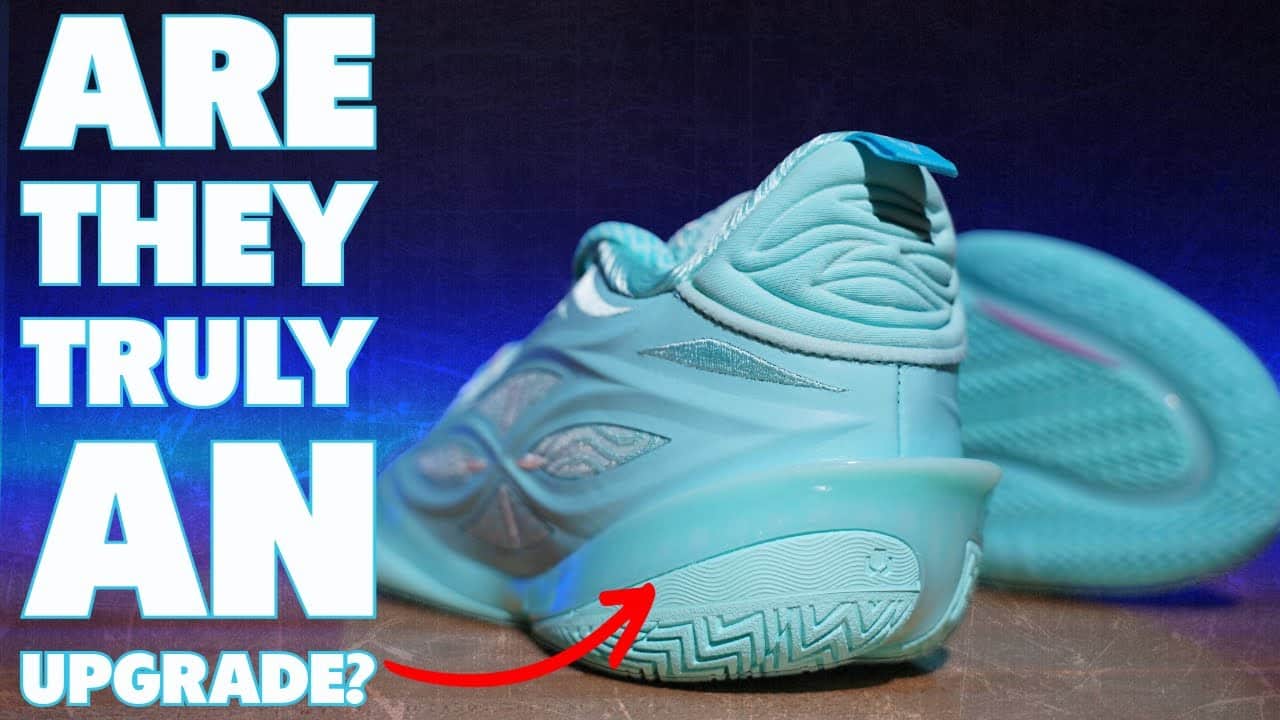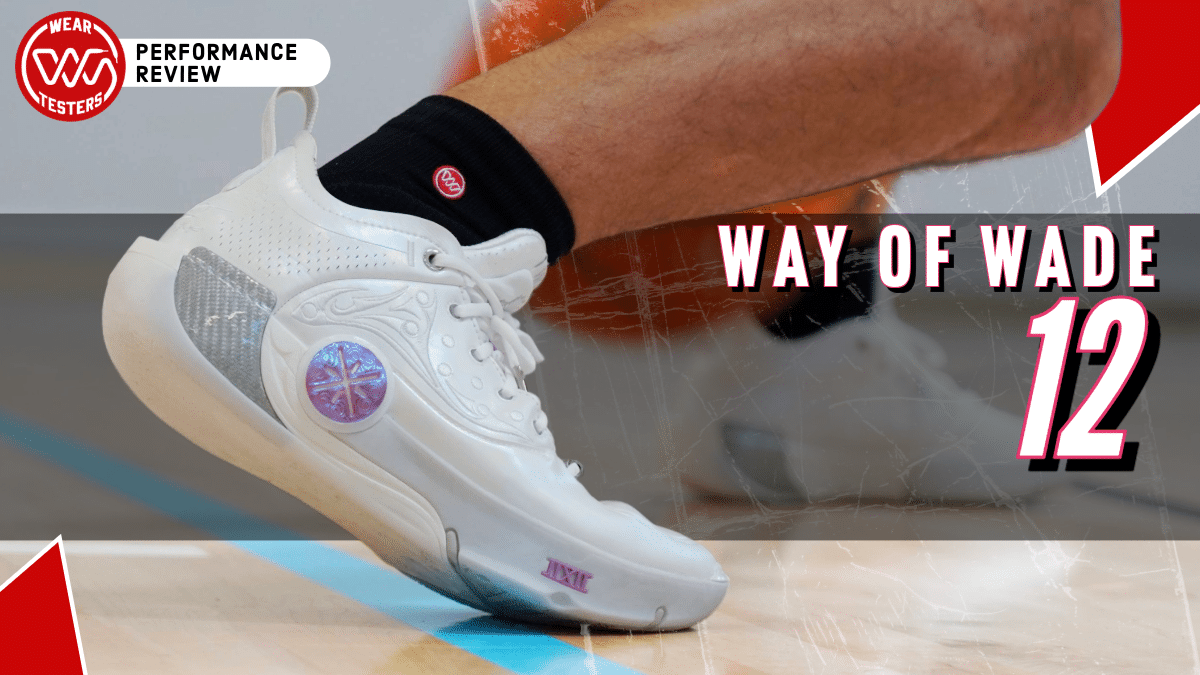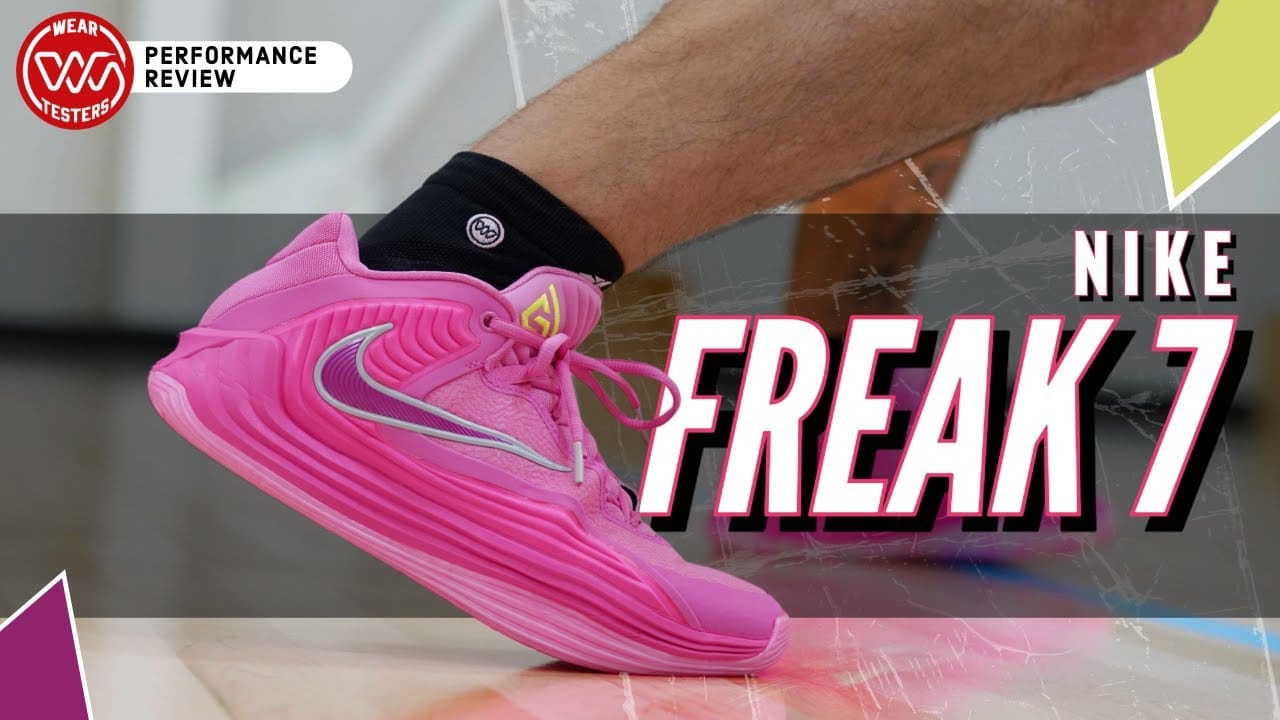Bye Pro Bounce, hello adidas Pro Boost Low…plus Lightstrike. Does the change elevate Adidas to the top of the team basketball shoe category? Find out below as Bryan and Jalique share their experiences testing the adidas Pro Boost Low. After hearing what they have to say, you can decide for yourself who rules in the world of team basketball shoes.
02/08 Update: The Pro Boost Low actually made our best adidas basketball shoes list for 2021-22
Adidas Pro Boost Low
Colorway: Chalk White
Release Date: November 2020
Style Code: FW9497
Price: $105 $59
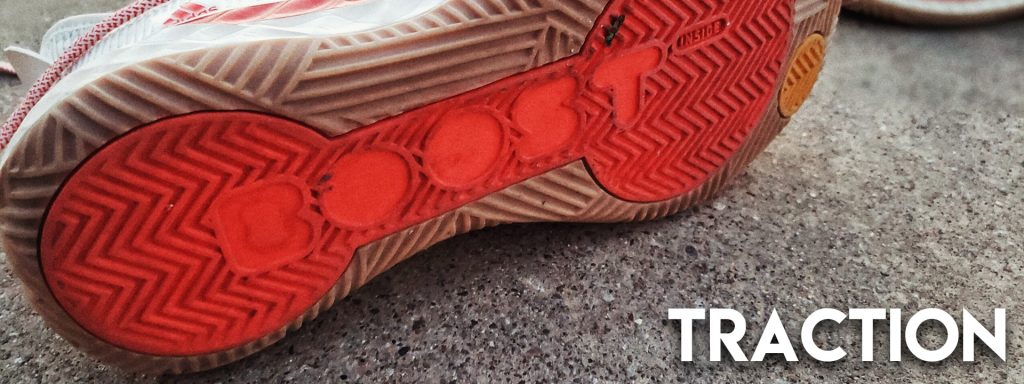
Traction
Bryan: Herringbone, herringbone, herringbone. How many times have we said “herringbone” at WearTesters and rejoiced when it appears on a new shoe. The reason is that herringbone works, and the majority of the time it works well (ok, the adidas Dame 6 did let me down). The Pro Boost Low uses a full herringbone pattern in the middle of the outsole (the Boost section) with a modified pattern covering the rest of the outsole. With some slight wiping about every third game this pattern worked as well as any shoe in my arsenal. It isn’t an aggressive stop, but a smooth roll into stillness. Even on stop-and-go, hesitations and step-backs, I didn’t slide at all.
Laterally, forward, backward, even on defense moving to get in front of my man, I was grabbing the floor then pushing off to change directions without a second thought. The best feeling in the world is in transition. I knew I could catch the ball on the move and either stop and pop, put it on the floor and drive, or do a one dribble pull up without any problems from the ankle down.
Playing outdoors? Actually, yeah, it might work. The pattern is definitely outdoor-friendly. The rubber, while not the thickest pattern, is slightly harder than most and should last for a few months on the blacktop.
Jalique: Patterns? On point. Compound? On point as well. The colorway I tested utilized gum rubber so it could differ slightly from other pairs. Regardless, the combination of herringbone surrounded by multidirectional blades didn’t disappoint no matter what movements I made.
Though I wouldn’t consider this a shallow traction set up, my only nitpick for the outsole would be to make it slightly deeper and/or to widen the grooves. This is something that would’ve helped me a bit after stepping in mud and caking things up a bit. But, maybe I’m the fool for trying to make Rodman saves outside after a couple of rainy days.
Though I primarily played outdoors in the Pro Boost with no issue, the time I spent indoors on a dusty court was still a good experience. I didn’t slip or wipe a lot despite utilizing all my typical our court movements. I’ll take it.
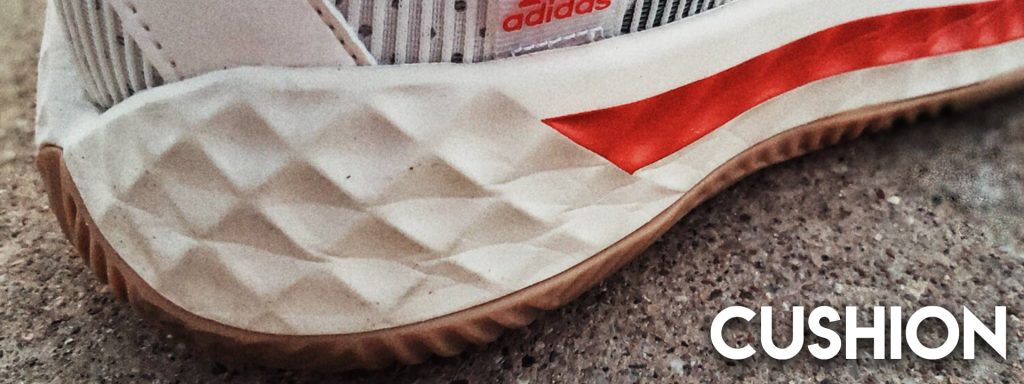
Cushion
Bryan: Wait. Waaaiiiiittt. WAIT!!!! WHAT????? Lightstrike, which we already know feels nice and soft and responsive from the Harden Vol 4, N3XT L3V3L, and Dame 6, is used as a carrier for…BOOST? Yeah, it is, and the cushioning feels freaking fantastic under foot.
I’ve heard from some in the WearTesters Discord that they couldn’t feel much cushion (no shade, everyone feels things differently). But I’m 210-215 pounds, so the compression is a tad bit stronger for me. The initial feel is the Lightstrike. It’s soft and cushioned under foot, feels great upon step-in, and it absorbs impact very well. At a certain point, the Lightstrike reaches its limit, which is where the internal Boost helps. When the Lightstrike starts to bottom out, the caged Boost is stiffer and responds with a spring. This system felt quicker than both the regular Lightstrike of the Dame 6 and the Boost in the Rose series while still being ultra-cushioned. This may be my favorite cushioning setup from adidas in years.
One thing to note. The Lightstrike does feel softer than the Boost, which can lead to some edge compression and collapsing if you land awkwardly. But in the two months I’ve played in the Pro Boost Low, this hasn’t caused any problems.
Jalique: The love-hate relationship with the Pro Boost midsole is real over here. It’s not anything like what I would expect from a shoe of its name, yet I find it to be a very solid setup. For those that asked for a more stable Boost setup, you get it here. But don’t expect the plushest Boost feeling since its caged inside the Lightstrike foam.
The midsole excels as a stable, low to the ground platform with surprisingly smooth transition. It’s got a subtle response underfoot that provides impact protection even if it doesn’t seem like its heavily absorbent. It’s not my favorite Boost option for basketball, but it is one I think a lot of players might enjoy, given the proper amount of time and break-in.
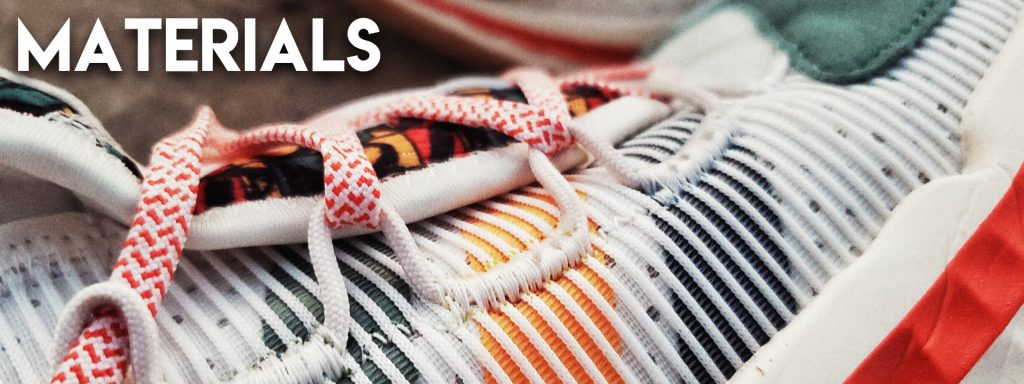
Materials
Bryan: The materials are pretty typical for what we get on most shoes these days. A fabric/textile/woven material (this one happens to be a nylon textile with tighter-woven ribs along the upper) and fuse areas for strength. Only, wait…no fuse here!!! This may be the first shoe since 2010 with absolutely no fused areas on the upper. The upper has no stretch at all along the sides of the shoe, meaning the fit is the fit from start to finish.
The toebox is covered in the lovely adidas felt material and a synthetic leather overlay. This many layers in the forefoot normally make a shoe feel stiff and inflexible. But the design and placement of the materials in the Pro Boost Low doesn’t hinder movement at all. The same pleather can be found on the heel as a layer for the counter, but it’s entirely unnecessary. The lace loops are a sewn-in cord system that doesn’t do any more than normal loops but does add to the looks.
The tongue is where things get interesting. There is a STRONG elastic band under the tongue that runs over the top of the foot. The tongue is then sewn on top of the band, meaning the tongue is external from the shoe. It is sewn in at the bottom and across the band but otherwise is unattached, making entry into the shoe easy. The heel and ankle areas feature some thick padding and I didn’t get any chafing at all in that area.
Jalique: I’m honestly over the materials adidas uses for nearly all of their hoops models. The Pro Boost does its job from a performance perspective minus one issue I have, but it’s discouraging to see some of the cheapest textiles and synthetics on hoop shoes. Especially when things like felt materials are used so minimally. Why use the felt at all? I wish they wouldn’t.
The synthetic toecap doesn’t hinder performance and is there for durability purposes. It does take away from the on-foot consistency from heel to toe, especially since the the midfoot gore band keeps the shoe so close to the foot in comparison to the toe’s extra volume.
Speaking of the gore band, there is no buffer between it and your foot, so if it bunches up, be prepared for some unwelcome pressure. Still, the shoe is tolerable enough for a few hours of play and adds containment, making this a secure option.
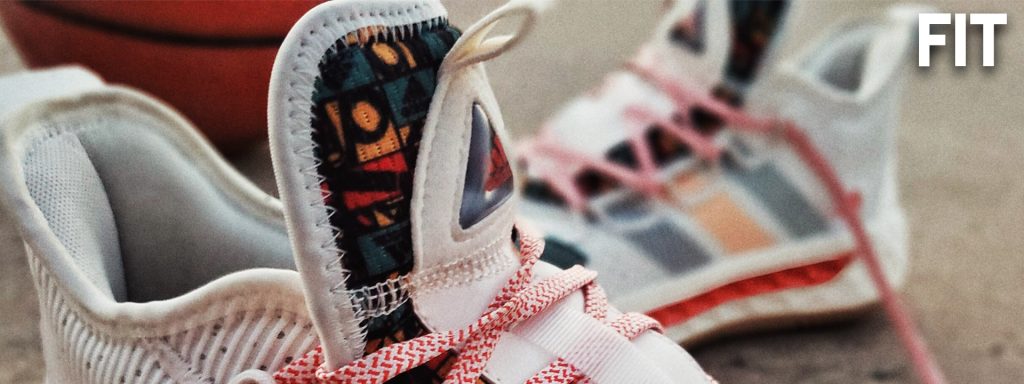
Fit
Bryan: I’m resigned to the fact that I am a size 10 in adidas (minus the D.O.N. Issue 2…smh). I’m normally a 10.5 in everything Under Armour, Nike, or Jordan. I went down a half size in the Pro Boost Low and the fit is perfect. For reference, I’m a 10 in the Dame 5/Dame 6 and a 10 or 10.5 in the Harden Vol 4. The midfoot has no movement at all from the lacing and the elastic band. The lacing and strap also pull the shoe up and around the ankle/achilles to stop movement of any kind. With the external tongue, the laces feel like they pull the shoe down on top of the foot for further lockdown.
Jalique: Regardless of what size works for you, the gore band seems effective around the midfoot. I prefer the fit of a half size down over true to size. Even going down a half size feels a bit longer than what I am accustomed to.
Because the midfoot band does not extend down to the footbed, I am more concerned with how those with higher insteps will adjust to the Pro Boost Low versus wide footers. For either, I would highly recommend knowing the return policy where you purchase in case the shoe doesn’t work out. Or, of course, try them on in store if circumstances allow.
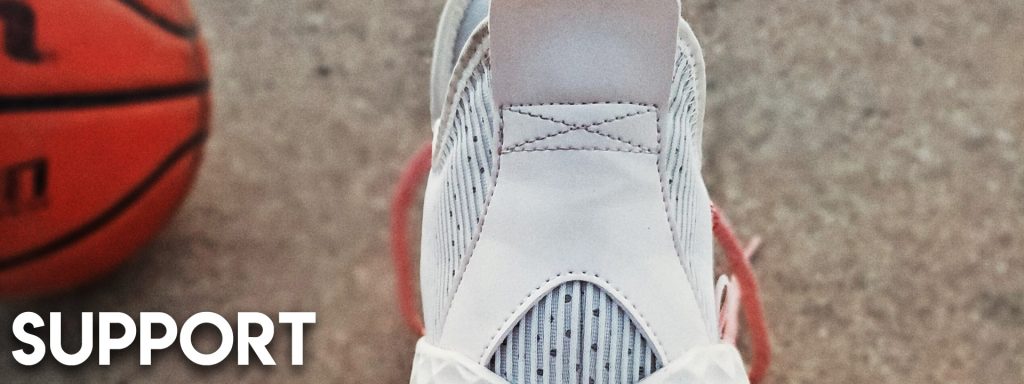
Support
Bryan: The first support feature I noticed was the way the midsole cups the foot and also flares slightly under the heel and forefoot. There’s no real outrigger to speak of, but the Pro Boost Low has a wide base with a slight angled flare under the forefoot. The Lightstrike comes up almost 1/4″ around the entire foot, working to keep your foot secure over the midsole, and it works great without feeling bulky. Confidence is the most important part of shooting and it starts with a solid base and the Pro Boost Low’s base is solid.
I don’t feel a midfoot shank embedded in the Boost. Even without it, the Pro Boost Low provides great arch support and midfoot stiffness. The heel counter is really stiff. The lacing system and the heel counter lock in your foot, thus providing ample true ankle support.
Jalique: If there is one thing you can count on in recent adidas basketball shoes, it’s the inclusion of a stable, and at times creative, platform. While visually the Pro Boost Low’s midsole isn’t quite creative, it fits the bill for stability with a nice wide and flat base.
The gore band, if you couldn’t already deduce, is effective. But I haven’t mentioned heel stability. Although it doesn’t feel like the heel counter is substantial due to the low height of the sneaker, the heel lockdown worked fine. Stop and go, two-way lateral movements, pivots, defending back cuts…all of it worked well for me.
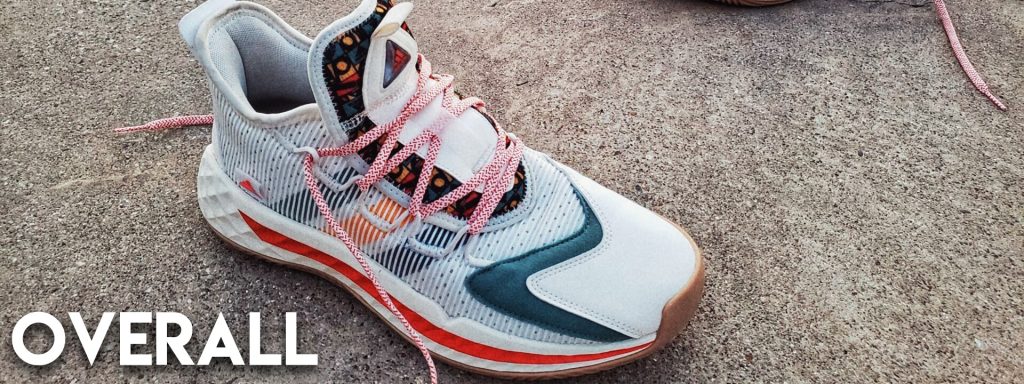
Overall
Bryan: The adidas Pro Boost Low is now my go-to shoe of 2020. Seriously. If I’m going to a new court, or one I know is bad, I take both a review pair and the Pro Boost Low. If you’re looking for cushion, traction, and fit, I can’t think of another shoe that will perform as well. While I was excited about the prospect of a drop-in Boost midsole, the midsole construction is better than I dreamed. Seriously, besides the adidas “suede”, I can’t think of a single bad thing about this shoe. Even the crazy tongue setup isn’t bad per se.
Jalique: Though not exactly what I expected, the adidas Pro Boost Low is a solid performer. With a mid option also available, the Pro Boost should fit the preferences of all types of players with its biggest flaws (the instep issue) not really hindering performance much, if at all.
The adidas Pro Boost Low is worth a try if you’re considering it as your next hoops shoe.
You can currently buy the adidas Pro Boost Low in 11 colorways and the adidas Pro Boost Mid in 10 colorways at adidas.
adidas Pro Boost Low: Bryan’s Scorecard
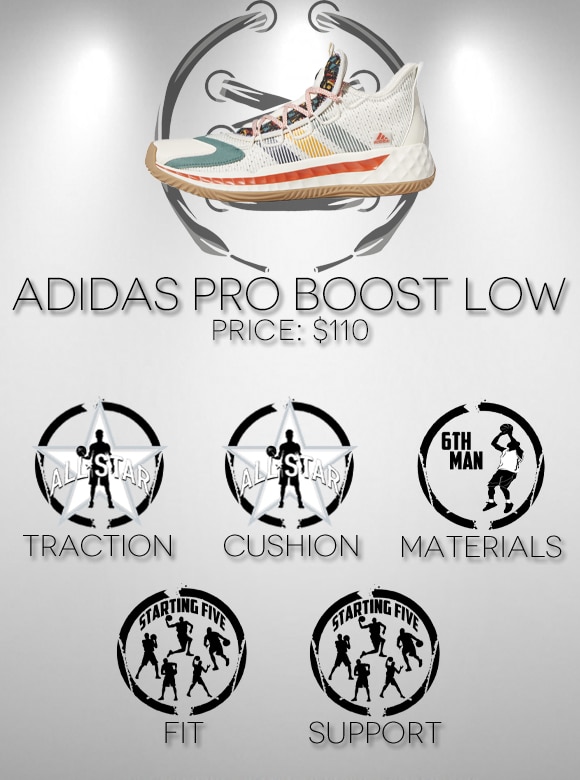
adidas Pro Boost Low: Jalique’s Scorecard
